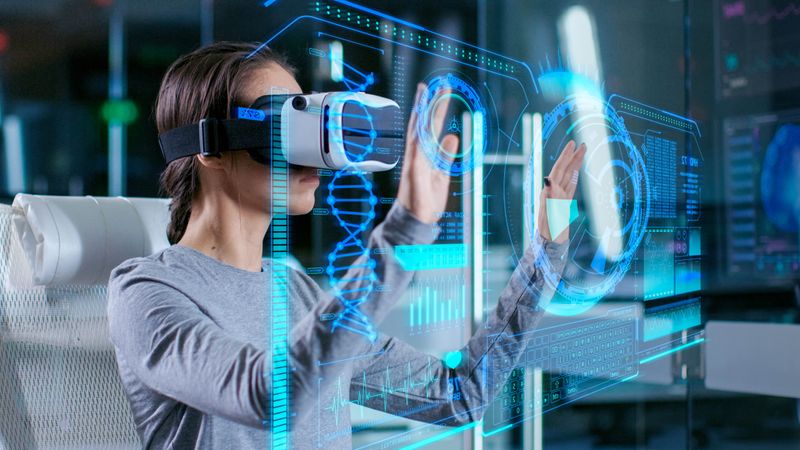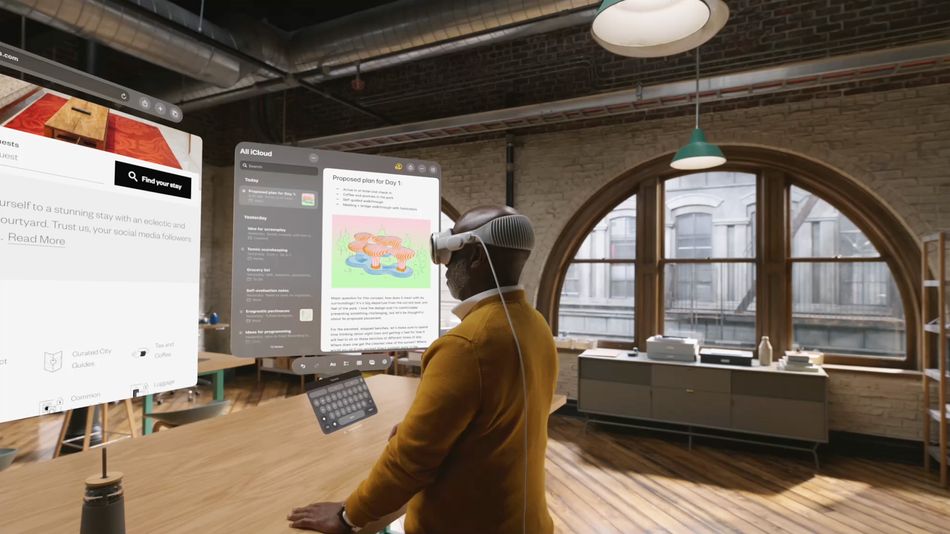The Engineering Behind Portable, High-Efficient VR Hardware
Learn more about the cutting-edge technology that VR hardware demands to provide immersive experiences.
Virtual Reality (VR) has transformed how we interact with digital content by providing immersive and captivating experiences within virtual environments. However, behind the awe-inspiring experiences, there is a complex engineering set, which includes high-resolution displays, accurate tracking, powerful rendering techniques and GPUs, efficient data and heat transfer technologies, miniaturization, and more.
This article steps into the fascinating but challenging world of VR hardware engineering. It explores technologies that have been used to create high-efficient, lightweight, and miniaturized headsets.
Optics and Display Systems
VR headsets use high-resolution displays and optics to create immersive visual experiences. These devices are designed to transport users into virtual worlds by presenting stereoscopic images that mimic real-life depth perception.
In the context of miniaturizing VR hardware, optimizing optics and display systems becomes crucial. Maintaining high-resolution displays while reducing the size, weight, and power consumption of the headset is complex. This requires advancements in display technologies, such as miniaturized OLED or LCD panels with high pixel density. Nanotechnology plays a crucial role in advancing display technology for VR applications, particularly in achieving higher resolutions. It enables the fabrication of smaller pixels, resulting in higher pixel density and enhanced image sharpness. In addition, the demanding data transfer protocols necessary for VR, such as 5G, heavily rely on advancements in nanotechnology.
To address size constraints, engineers have focused on compacting the optical systems while maintaining wide fields of view. Advanced lens design techniques, such as aspherical lenses, can help achieve a wider FOV while minimizing the physical size of the optics. Additionally, distortion correction algorithms play a significant role in compensating for geometric distortions and ensuring image quality across the entire display area.
Reducing motion blur is another challenge in VR hardware. Increasing the display's refresh rate and optimizing response times of the display technology help minimize motion blur during head movements. Advanced motion smoothing techniques, such as motion vector prediction and frame interpolation, can further enhance the visual experience.
To address the screen door effect in a miniaturized VR headset, display technologies with higher pixel density and improved sub-pixel arrangement should be considered. Additionally, incorporating optical filters like diffusers or anti-reflective coatings can help reduce the visibility of pixel gaps and enhance the overall visual quality.
Tracking and Positional Accuracy
Another important piece of the VR hardware set is the tracking system. However, capturing user movements accurately while minimizing the size and power requirements of the tracking components has been a big challenge.
Traditional tracking systems employ active IR and laser-based systems for tracking. Active IR tracking involves emitting infrared light from a source and using sensors to detect reflections from markers on the user's head or peripherals. On the other hand, laser-based tracking systems use lasers and sensors to measure the time the rays return after hitting markers, allowing for accurate motion tracking. However, adapting these systems for miniaturized hardware requires advancements in sensor miniaturization and energy-efficient designs.
Also, integrating sensors and combining data from multiple sensors is crucial in improving accuracy and reducing latency. By integrating sensor functionality into a compact form factor, the overall footprint of the tracking system can be minimized. Additionally, leveraging prediction and filtering algorithms helps smooth out movements and ensures real-time responsiveness.
Occlusion is another challenge in tracking systems when objects obstruct the line of sight between sensors and markers, leading to inaccurate or lost tracking. In order to minimize these problems, techniques like sensor integration, inverse kinematics, and sensor fusion can be employed.
Achieving precise positional accuracy in VR can be challenging due to sensor limitations, calibration requirements, environmental factors, and system latency. Calibration techniques can align sensors and markers for accuracy, and sensor resolution and precision provide detailed and precise tracking. Furthermore, sensor fusion can also optimize positional tracking by combining data from multiple sensors.
Graphics Processing Units (GPUs) and Rendering Techniques
VR systems have been taken to a higher level due to the advance of GPU technology. Some of these improvements are higher frame rates and lower latency, which can be achieved by dividing complex tasks into smaller subtasks and executing them simultaneously across multiple parallel processing units. The performance of GPUs can be further improved through optimization techniques, such as fine-tuning algorithms and system configurations, to maximize efficiency and reduce processing overhead.
Asynchronous Time Warp (ATW) and Space Warp (ASW) are techniques that have been used to ensure a smooth, immersive VR experience. ATW predicts head movements and warps previously rendered frames accordingly, reducing visual lag. ASW extrapolates intermediate frames based on head and hand motion, reducing latency and improving system responsiveness.
VR is also enhanced by real-time rendering algorithms that create immersive visuals. These algorithms utilize techniques such as Level of Detail (LOD) management, which adjusts the level of detail in objects based on their distance from the viewer for efficient use of computational resources. Culling and occlusion techniques are also used to eliminate the need to render objects that are not visible, which reduces unnecessary computations. Furthermore, dynamic lighting and shading techniques simulate realistic lighting conditions, creating more visually natural virtual environments.
Connectivity and Data Transfer
During transmitting data without physical connections, VR systems rely on wireless communication protocols like Bluetooth and Wi-Fi. For a seamless experience, low latency and high bandwidth are crucial. Furthermore, interference mitigation and Quality of Service (QoS) techniques help maintain a robust wireless communication link by prioritizing essential data and minimizing the impact of external signals.
Good signal range and stable connections are necessary to prevent disruptions or dropouts during usage. Therefore, the signal range determines the maximum distance between the transmitter and receiver, while stability refers to the reliability of the connection.
Nanotechnology plays a pivotal role in establishing seamless and responsive communication between various elements of virtual reality by bridging the gaps that exist between processors and input environments. Moreover, in order to minimize the amount of data transmitted over wireless channels, data compression techniques can be used. Lossless compression preserves all original data, while lossy compression sacrifices some details to achieve higher compression ratios. Still, adaptive compression adjusts the compression level based on the available bandwidth and quality requirements.
Minimizing delays during data compression and decompression processes to maintain real-time interactions in VR is also complex. In order to mitigate this issue, synchronization methods like time stamping enable precise timing coordination between devices and buffering and interpolation techniques smooth out variations in data transmission rates.
Power Management and Heat Dissipation
In order to ensure maximum battery life and reduce power stress, VR headsets rely on power efficiency techniques, which can be enhanced by leveraging nanotechnology. This involves carefully selecting energy-efficient components and implementing power optimization methods like voltage scaling, clock gating, and dynamic power management. Nanoscale materials and structures can improve power efficiency by enabling better control over power consumption and minimizing energy loss.
Moreover, thermal management is crucial during the operation of VR headsets, as they generate substantial heat. Nanotechnology can play a role in thermal management by offering advanced materials and designs that facilitate efficient heat distribution and dissipation. Heat spreading techniques, ventilation systems, and airflow mechanisms can be enhanced by nanoscale features, allowing for better heat dissipation and maintaining optimal performance.
Nanotechnology also enables the development of thermal interface materials that enhance heat transfer between different components, optimizing the overall cooling process. Additionally, nanosensors can be integrated into VR headsets for precise temperature monitoring and control, ensuring that cooling mechanisms operate within safe temperature limits.
Hardware Miniaturization and Portability
Creating high-performing and portable VR devices is a complex task that involves reducing components to nanoscale and improving ergonomics. Significant advancements in this field have made VR experiences more accessible and comfortable for a wider range of users.
Miniaturization
The miniaturization of components, especially with the advancements in microelectromechanical systems (MEMS) technology, has played a crucial role in VR hardware engineering. Smaller, more power-efficient sensors like accelerometers, gyroscopes, and magnetometers enable accurate tracking within compact VR devices. Additionally, battery miniaturization has also been essential in ensuring that VR hardware is portable and has longer usage times. Optics and lens systems also have improved, resulting in smaller, lighter lenses with high quality.
Integrated System-on-Chip
Integrated System-on-Chip (SoC) chips also have been employed to integrate processors, GPUs, memory, and sensors in a single chip. Therefore, using SoCs allow the optimization of power consumption and performance.
Lightweight Materials
Another feature that made it possible to minimize weight and enhance the comfort of VR headsets is lightweight materials, including advanced polymers, fabrics, and textiles. This allows the engineers to focus on ergonomics and comfort. Therefore, considering weight distribution, adjustable straps and interfaces, ventilation, heat dissipation, and user interface design ensure a comfortable and immersive user experience.
Overall, the progress made in miniaturization, lightweight materials, and ergonomic design advancements has significantly improved VR hardware engineering. Apple's Vision Pro is an excellent demonstration of how VR technology can be made smaller and more portable. It lets users blend digital content with their surroundings, making it easy to navigate using only their eyes, hands, and voice. Furthermore, it has a sturdy design that includes 3D glass and an aluminum frame that fits comfortably on the face.
Conclusion
VR hardware engineering encompasses a multitude of complex challenges, from optics and displays systems to tracking accuracy, GPU performance, connectivity, power management, and heat dissipation. Nanotechnology plays a pivotal role in addressing several of these challenges, particularly in the advancement of display technologies, data transfer protocols, and power consumption minimization. By leveraging nanoscale materials and structures, VR headsets can achieve higher resolutions, improved power efficiency, and enhanced thermal management. As VR technology continues to evolve, further advancements in nanotechnology and engineering practices will continue to push the boundaries of what is possible in the realm of virtual reality.
About the sponsor: Mouser Electronics
Mouser Electronics is a worldwide leading authorized distributor of semiconductors and electronic components for over 1,200 manufacturer brands. They specialize in the rapid introduction of new products and technologies for design engineers and buyers. Their extensive product offering includes semiconductors, interconnects, passives, and electromechanical components.
References
[1] Edd Gent, 2022. “The Tech That Will Push VR to the Limits of the Human Eye”
[2] David Heaney, 2019. “How virtual reality positional tracking works”
[3] Nur Haliza Abdul Wahab, Faisal Saeed and Nouf Alharbi, 2022. “360-Degree Video Bandwidth Reduction Techniques”
[4] Rahul Awati, 2022. “What is field of view (FOV)?”
[5] Alan Truly, 2023. “What is screen door effect in VR?”
[6] Russell Kidson, 2023. “Understanding the Screen Door Effect in VR Headsets”
[7] L. Wang et al., 2019. “Occlusion Management in VR: A Comparative Study”
[8] Efe Udin, 2022. “Top 10 challenges of Meta VR headsets”
[9] Jabil. “Top Six Augmented and Virtual Reality Technology Challenges”
[10] John Koon, 2022. “Design And Security Challenges For VR”




